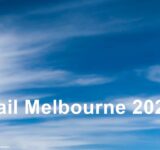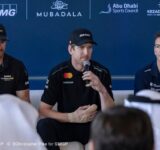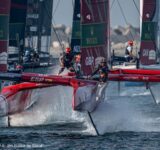The flight of the INEOS Team UK’s first AC75 ‘Britannia’ on the waters of the Solent, where the first America’s Cup event took place back in 1851, highlighted the dramatic changes that have taken place in sailings premier racing event.
The AC75 that will compete in Auckland in March 2021 is fundamentally different from what has gone before. The single-hulled, keelless AC75 has none of the multihull’s inherent stability at rest. Designers and sailors have had to find new techniques to get the boats to accelerate and take-off onto the foils.
170 years after the first race around the Isle of Wight the AC36 teams will race for less than an hour at a time on short courses off Auckland Harbour, and the eleven sailors will use sophisticated electronic systems and hydraulic-driven actuators to control the boat.
The America’s Cup has been contested in foiling boats since 2013, but previously the boats were twin-hulled catamarans and this is a return to a mono-hull design. The AC75 has openly embraced the foiling era by allowing flaps on the hull T-foils, the same control system that would be used on an aircraft.

It allows for greater sophistication in the hydrodynamic design, but significantly increases the complexity of the engineering required to design and build the systems.
The result is almost certainly the fastest boat capable of racing around an America’s Cup course. This is both the ultimate racing sailboat and a step into the unknown.
There will also be a significant physical challenge.
Even though the rules allow batteries to power adjustment of the hydrofoils, the crew still have to power control and movement of the sails, when combined with the instability of the monohull AC75, it means the sailors will have to work harder than ever.
Four AC75 have been launched to date. One by Emirates Team New Zealand the America’s Cup defender, and one each by the three challengers: Ineos Team UK, the New York Yacht Club American Magic, and the Luna Rossa Prada Pirelli Team.

All four teams have assembled top class design and research teams and spent many thousands of hours on the design and construction of these first AC75 hulls, resulting in four boats that have performed well in initial trials straight from the launch.
“The first sail of a new boat is always a big day for the people that designed and built it, and that’s even more so when it’s the launch of the first of a brand new concept of boat. The team have all worked incredibly hard to get this far and seeing her out on the water is the first reward for all that effort. It’s also the start of a process of learning for the second boat that will take us into the America’s Cup.”
Ben Ainslie, INEOS Skipper and Team Principal
The teams are all expected to build a second boat, which can be launched after February 2020, based on the performance of their intial design in the testing stages and at the first race event for the class in Cagliari, Sardinia, in April 2020.

The designs revealed so far split into two distinct interpretations of the AC75 Class Rule, scow and skiff. Which begs the question . . . who is right and do you switch boat types mid-stream?
When INEOS Team Head of Design Nick Holroyd was asked if the second Ineos boat would be more radical, he replied . . .
‘It will be different . . . even if you think you are right you would not build another one the same. I am not arrogant enough to think I am right. And there is a lot to learn from other people, to put resource into different places in the design cycle.’
‘There are some easy wins . . . these guys have put a lot of effort in there, what did they find and we incorporate? And I am happy to be shameless and copy if that gets you ahead?’
There is also the option to alter the existing hull by 12.5% of the hull surface area, which gives teams the ability to try to correct or experiment during the testing or early event stage, before the second boat is available (the 12.5% change rule applies to both boats).
Although nothing has been heard of the second boat design/build programmes, time factors would suggest that construction of the teams’ second AC75’s will need to be well under way early in the new year.

Meanwhile testing and training in the first AC75 designs continues apace . . .
The INEOS team is carrying out intial testing on the waters of the Solent near their headquartes, but will move to Cagliari by December to avoid the British winter and gain time on the first event racetrack.
The American Magic team are presently relocating from Rhode Island to Pensacola, Florida for the winter, while the New Zealand team are carrying out testing at their home base waters before moving to Cagliari in early 2020.
Luna Rossa have the home pitch advantage for the first scheduled event in April 2020, and the luxury of being able to test and tune their boat unintrrupted by transportation concerns.
The American and New Zealand teams will lose considerable time shipping their boats to Europe, up to 40 days in the case of ETNZ, and then re-transporting them to the USA for the America’s Cup World Series event.
Although Cagliari is the only ACWS event officially announced to date, it is expected that there will be at least one more event in Portsmouth UK, and that the USA event may be skipped. Apparently this all has to be decided by the end of this November.
Related Post:







